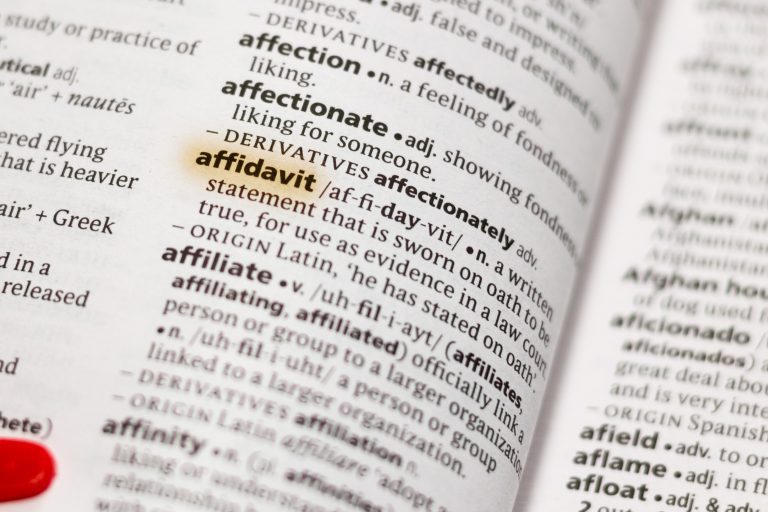
Article written by Rosemary Bocska
To the layperson, the Canadian legal process can be confusing at the best of times. The most basic elements – like terminology – will be something that the average person will have little experience with. Consequently, common legal terms, which may be routinely mentioned on modern-day TV crime dramas or celebrity courtroom programs, may not be well-understood by many, even though they will have been part of the legal process for centuries.
“Affidavit” is one of those terms.
The Concept, and the Terminology
An affidavit is simply an oath in writing signed by the party making it. That person is the “deponent” or “affiant” and the oath is “sworn” by them. Therefore, it makes a promise that the contents are true. There are certain legal requirements for how documents are sworn, including the need for a witness.
The affidavit, in other words, contains the written version of the “story” of the person who makes it. A story pertaining to the specific legal issues and information relevant to his or her case. It contains the evidence filed with and presented to the court for its consideration.
When Are Affidavits Used in Family Law?
Affidavits are a vital part of all sectors of the law (e.g. civil or criminal law). Moreover, Family Law usually requires them filed by each party to the litigation. These support virtually any kind of application or step, such as:
- Applying for a court order for child support or spousal support;
- Applying for an order to determine child custody or access rights (i.e. parenting time);
- Applying to change, suspend or terminate an existing order;
- Making a petition for divorce, and related issues;
- Applying to equalize Net Family Property;
- Applying to set aside all or part of a separation agreement or other domestic contract;
- Bringing a motion for any type of interim remedy or procedural ruling; and
- Responding to any of the above types of legal processes, when they have been launched by another person (i.e. usually the other parent or former partner/spouse).

What Form Does an Affidavit Take?
In Ontario Family Law matters, Family Law Rules mandated all forms of affidavits. There are no less than 14 different prescribed affidavits, all available on the government’s “Court Forms” website online.[1]
Occasionally, some of them will tailor to particular aspects or types of proceedings. The General Affidavit, which (as the name suggests) serves many purposes, is Form 14A.[2] Another very common one is the “Affidavit of Service”[3]. This is a specialized form to be used by each party as proof that he or she has formally served court documents on the other spouse or parent, as required by the Family Law Rules.
For more routine disputes and applications, some of the other commonly-used affidavits include:
- For custody and access matters, the “Affidavit in Support of Claim for Custody or Access”, found as Form 35.1[4];
- Form 26B, “Affidavit for Filing Domestic Contract with Court”[5]; and
- The Affidavit for Divorce, which is Form 36.[6]
The Ontario government website has tailored resources and tips for drafting some of the specialized affidavit forms.[7]
What Should the Affidavit Contain?
Since given under oath and then filed with the court, an affidavit should naturally be clearly-drafted, completely accurate, and thorough. Also, it must not be drafted in a manner that misleads the court or other readers.
Although offered in the context of a wiretap authorization in a criminal trial in a case called R. v. Araujo[8] the Supreme Court of Canada has offered practical advice and guidelines on what an affidavit should ideally include (or not include). These tips are equally germane to affidavits prepared for Family Law matters; according to the Court a good affidavit should:
- Contain full and frank disclosure of material facts;
- Set out the facts truthfully, fully, and plainly;
- Be clear and concise;
- Should not attempt to trick its readers;
- Avoid boiler-plate language; and
- Ideally, obtained directly from those with the best firsthand knowledge of the facts that are described in it.
The Supreme Court added, “So long as the affidavit meets the requisite legal norm, there is no need for it to be as lengthy as À la recherche du temps perdu, as lively as the Kama Sutra, or as detailed as an automotive repair manual.”
[1] The Family Law Rules Forms: http://ontariocourtforms.on.ca/en/family-law-rules-forms/
[2]http://ontariocourtforms.on.ca/static/media/uploads/courtforms/family/14a/flr-14a-e.pdf
[3]http://ontariocourtforms.on.ca/static/media/uploads/courtforms/family/06b/flr-6b-e-1016.pdf
[4] No direct PDF link to Form 35.1, find the form on the government’s Ontario Court Forms website in Word format. See: http://ontariocourtforms.on.ca/en/family-law-rules-forms/
[5] No direct PDF link to Form 36B, find the form on the government’s Ontario Court Forms website in Word format. See: http://ontariocourtforms.on.ca/en/family-law-rules-forms/
[6]http://ontariocourtforms.on.ca/static/media/uploads/courtforms/family/36/flr-36-e.pdf
[7] See for example the Ministry of the Attorney General’s Self-Help Guide titled, “Asking for a Custody or Access Order” found online at: https://www.attorneygeneral.jus.gov.on.ca/english/family/guides/Parenting_Affidavit_Self-Help_Guide-EN.html
[8] 2000 SCC 65, 2000 CarswellBC 2440, 2000 CarswellBC 2438, [2000] 2 S.C.R. 992, [2000] S.C.J. No. 65.
%201.png?)
